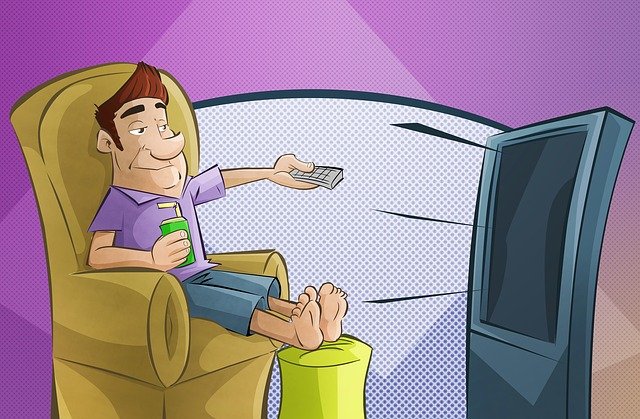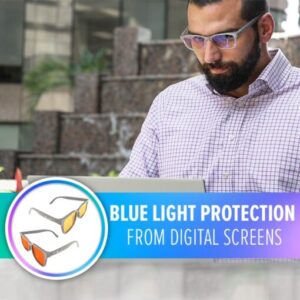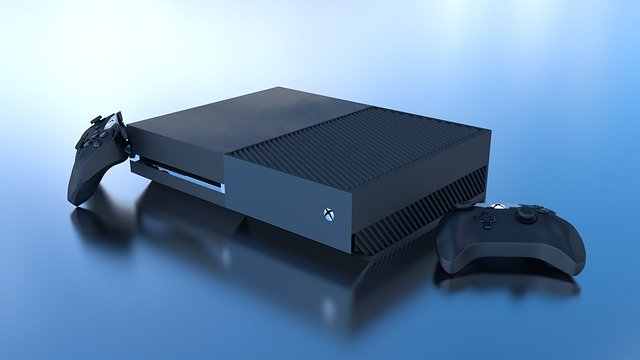
Television has become an essential part of our daily life. It is rare to find a household without at least one television. According to statistics, the average person spends at least 4 hours per day in front of a tv.
TV pixels emit blue, red, and green light to provide a crisp and clear image display. Yet, there have been concerns about the adverse effects of blue light emitted by TVs on the eye and our sleep cycle.
Studies have shown that blue light emitted by televisions might indeed be detrimental to vision and decrease melatonin levels in our brain. If you want to know more about blue light emitted from TVs and their nefarious effects, keep reading!
How does TV work?
Old televisions produced images from a cathode ray tube (CRT). A small tungsten wire inside the television is heated and when it becomes hot it releases electrons.
Electrons are small negatively charged particles that make up an atom. These electrons are propelled to hit a screen coated with a special material which gives out a bright spot when an electron hits it.
The screen contains a coating mix which gives the three primary colours: red, blue, and green. By mixing the appropriate proportion of the three colours, an image is produced.
In contrast, modern televisions use light-emitting diodes instead of CRTs. The screen is of a liquid crystal display (LCD) type.
The screen is divided into tiny spots called pixels which can emit red, blue, or green light and by varying degrees. By controlling the amount of the three colours emitted, crisp images then are produced.
What is blue light?
The light emitted by television is called visible light. Visible light can further be classified into sub-parts that differ in terms of wavelengths – the length of each wave.
Starting from largest wavelength to smallest wavelength, visible light can be broken into the following components:
- Red
- Orange
- Yellow
- Green
- Blue
- Indigo
- Violet
The wavelength of blue light ranges from 380 nm to 500 nm, 1 nm is equal to one metre shared into 1 billion equal parts.
Negative effects of blue light
According to the laws of physics, the shorter the wavelength, the more energy the colour carries. For instance, red light carries less energy than violet since red has a longer wavelength.
From a similar argument, blue light is near the lowest wavelength components of visible light and carries more energy than red light.
The larger amount of energy can be linked to the adverse effects of blue light on the eyes. The cornea, which is the surface part of the eyes, does not block blue eyes.
Therefore, blue light reaches the retina – the muscle at the back of the eye which decodes light falling on it and converts it into images.
Blue light may affect the retina and cause a disease called macular degeneration. Additionally, blue light can be easily reflected from any surface and hence causes the eyes to be strained because of squinting. Read my other post on can Bluetooth cause headaches, you can find it here.
The squinting can be especially harmful after cataract surgery. Moreover, scientists have found that too much blue light decreases the production of melatonin, a hormone that aids in relaxation and sleep.
While blue light can be helpful during the day to reduce feelings of sleepiness, it can prevent us from falling asleep by mimicking the properties of daylight.
Therefore, the brain disrupts circadian rhythms (sleeping cycles), resulting in alertness rather than tiredness and sleepiness.
A disruption in your sleep cycle can lead to severe impacts on your physical and mental health, such as depressions and metabolic disorders. For more take a look at my other post what Is the side effects of Bluetooth radiation here
How to reduce the effects of blue light?
There are several ways to reduce blue light exposure, including frequent breaks, blue light filters, melatonin supplements, and eye exercises. You can order Anti-blue light glasses here.
Frequent breaks
The most logical way would be to limit your screen time. Our eyes have not evolved to remain in a strained position for long hours in front of the TV.
To minimise the effect of strained eyes, you can take frequent pauses of 5-10 minutes from the screen. Additionally, research has shown that a complete break at least 3 hours before bedtime from screens results in better sleep quality.
Blue light filters
Besides, most modern TVs nowadays have blue light filters that you can switch on. The filter changes the tone of the light discharged from the screen to a warmer tone, which is better for your eyes.
To use the filter, simply go to the Settings menu and pick the Display choice. Then, search for the blue light channel to put it on.
If you cannot find the setting, you might want to consult your proprietor’s manual. On the rare occasions that your TV does not have a blue light filter, you can purchase blue light protectors that you can attach to your screen.
They change the shade of the light and screen out the blue light.
Melatonin supplements
You can add melatonin supplements to your diet at night to improve the length and quality of your sleep.
One study carried out on patients having eye fatigues, insomnia and cerebral pains showed that taking supplements for a prolonged time did ease out their symptoms.
However, always consult your doctor before taking melatonin supplements as it may interfere with other treatments.
Eye exercises
You can find several simple eye exercises on the internet to reduce eye strain. They include the eye roll, the palm eye exercise, the eye press, mental figure-eight tracing and using the eyes to write messages on a wall.
You can also use the 20-20-20 rule to minimize eye strain caused by blue light. After every 20 minutes, look at an object that is 20 feet away from you for 20 seconds.
Blue light lenses

Opticians have designed blue light glasses for people who watch TV or work on a laptop for long periods.
These blue light blocking properties can also be added to prescription glasses for an all-in-one glass that improves your vision and protect your eyes from blue light. Order your pair here.


